Tenrec facts for kids
Quick facts for kids Tenrecidae |
|
|---|---|
 |
|
| Tailless tenrec (Tenrec ecaudatus) | |
| Scientific classification |
|
| Kingdom: | Animalia |
| Phylum: | Chordata |
| Class: | Mammalia |
| Order: | Afrosoricida |
| Suborder: | Tenrecomorpha |
| Family: | Tenrecidae Gray, 1821 |
| Type genus | |
| Tenrec Lacépède, 1799
|
|
| Subfamilies | |
|
|
A tenrec is a type of mammal that lives only on the island of Madagascar. Tenrecs belong to a special animal family called Tenrecidae. They are part of a larger group of mammals called afrotheria, which mostly live in Africa.
Tenrecs are very different from each other. Some look like hedgehogs, while others look like shrews, opossums, rats, or mice. They can live in many different places, like in water, in trees, on land, or even underground. For example, the greater hedgehog tenrec lives in the dry forests of Madagascar. However, most new tenrec species have appeared in the island's wet forests.
Scientists believe all tenrecs came from one common ancestor. This ancestor lived about 29 to 37 million years ago. It likely floated over to Madagascar from Africa on something like a natural raft. Their closest relatives are African otter shrews, and they split off from them about 47 to 53 million years ago.
Contents
What's in a Name?
The word tenrec comes from the French word for these animals. The French got it from the Malagasy word tandraka (or trandraka). This Malagasy word specifically refers to the tailless tenrec (Tenrec ecaudatus). Some people think the Malagasy word might be related to the word for porcupine.
How Tenrecs Evolved
Scientists think that all tenrecs came from a single species that arrived in Madagascar between 42 and 25 million years ago. How they got there is still a mystery. The most popular idea is that a few of them floated across the Mozambique Channel on plants or other natural rafts. This channel separates Madagascar from southeastern Africa. The Tenrecidae family is one of only four groups of land mammals that have successfully moved to Madagascar and developed into many different species there.
Once they were on Madagascar, tenrecs changed and adapted to fill many different roles on the island. Many of them started to look like other well-known mammals that are not found in Madagascar. For example, the two types of hedgehog tenrecs have spiky coats and can roll into a ball when they feel threatened. This is very similar to how true hedgehogs act. This is an example of convergent evolution. It means different animals develop similar features because they live in similar environments or face similar challenges. This helps scientists study how animals adapt over long periods of time.
Amazing Tenrec Features
Tenrecs are small mammals, but they come in many different shapes and sizes. The smallest ones are about the size of a shrew, only about 4.5 cm long and weighing just 5 grams. The largest, the tailless tenrec, can be 25 to 39 cm long and weigh over 1 kg. Even though they might look like shrews, hedgehogs, or opossums, they are not closely related to them. Their closest relatives are the otter shrews. After that, other African insect-eating mammals like golden moles and elephant shrews are also related. Scientists only realized these animals were related in the late 1990s. More research continues to show that they all share a common ancestor in the group called Afrotheria.
Tenrecs are some of the few land mammals that use echolocation. This means they make sounds and listen to the echoes to find their way around or hunt. It's like how bats use sound.
Unlike most placental mammals, tenrecs have a special body feature called a cloaca. This means their bottom opening for waste and their reproductive parts are combined into one. This is more common in birds, reptiles, and amphibians. Tenrecs also have a naturally low body temperature.
All tenrec species seem to eat a mix of foods, making them at least partly omnivorous. However, small animals without backbones, like insects, make up most of their diet. One species, Microgale mergulus, lives partly in water, similar to their relatives, the otter shrews. All tenrec species, whether they live in water or not, seem to have come from a single ancestor. While we don't have many tenrec fossils, some old ones from Kenya show they are similar to living species from Madagascar.
Most tenrecs are nocturnal, meaning they are active at night, and they don't see very well. But their other senses are very good. They have especially sensitive whiskers that help them feel their surroundings. The number and type of teeth tenrecs have can be very different from one species to another. What's unusual for mammals is that a tenrec's adult teeth don't fully grow in until the animal has reached its full size. This is one of several body features that tenrecs share with elephants, hyraxes, sengis, and golden moles. This suggests they all came from a common ancestor.
Tenrecs are pregnant for 50 to 64 days. They give birth to young that are not very developed. While otter shrews usually have only two babies at a time, the tailless tenrec can have as many as 32! Female tailless tenrecs can have up to 29 teats, which is more than any other mammal. Some tenrec species live in social groups with more than a dozen family members from different generations.
Tenrecs and People
On the island nation of Mauritius and the Comoran island of Mayotte, some people eat tenrec meat. However, it's not easy to find or prepare.
The lesser hedgehog tenrec (Echinops telfairi) is one of 16 mammal species whose DNA will be studied as part of the Mammalian Genome Project. This project aims to map the genes of many mammals. These tenrecs are also becoming popular as pets. In the future, they might be important animals for medical research. This is because they are not closely related to common lab animals like mice, rats, or guinea pigs.
Threats to Tenrecs
Scientists have looked at 31 species of tenrecs. Most of them (24 species, or 77%) are not considered to be in danger. One species doesn't have enough information to decide its status. However, 4 species are considered Vulnerable, and 2 species are Endangered. This means they are at risk of disappearing.
The safety of many tenrec species is a worry because threats have increased a lot in the last 50 years. The main dangers for tenrecs include losing their homes because of deforestation (trees being cut down), their habitats being broken up, hunting, accidentally getting caught, and climate change. Farming methods like slash-and-burn (cutting and burning forests) and mining for metals are hurting tenrec species that live in forests. Five out of the six threatened tenrec species depend on forests to survive.
Protecting Tenrecs
As of 2022, protecting tenrec populations is not a top priority for conservation efforts. Since most tenrecs need forest homes, conservation plans would need to focus on stopping deforestation in Madagascar and helping forests grow back. One current effort is the Madagascar Ankizy Fund. This fund was started by a team of scientists from Stony Brook University. It helps improve health care and education for people in remote villages in Madagascar. A healthy and educated local population will, in the long run, help protect the animals of Madagascar, including tenrecs.
Tenrec Species
Here are the three main groups (subfamilies), eight genera, and 31 living species of tenrecs:
FAMILY TENRECIDAE
- Subfamily Geogalinae
- Genus Geogale
- Large-eared tenrec (Geogale aurita)
- Genus Geogale
- Subfamily Oryzorictinae
- Genus Microgale
- Short-tailed shrew tenrec (Microgale brevicaudata)
- Cowan's shrew tenrec (Microgale cowani)
- Drouhard's shrew tenrec (Microgale drouhardi)
- Dryad shrew tenrec (Microgale dryas)
- Pale shrew tenrec (Microgale fotsifotsy)
- Gracile shrew tenrec (Microgale gracilis)
- Grandidier's shrew tenrec (Microgale grandidieri)
- Naked-nosed shrew tenrec (Microgale gymnorhyncha)
- Jenkins's shrew tenrec (Microgale jenkinsae)
- Northern shrew tenrec (Microgale jobihely)
- Lesser long-tailed shrew tenrec (Microgale longicaudata)
- Microgale macpheei (extinct)
- Major's long-tailed tenrec (Microgale majori)
- Web-footed tenrec (Microgale mergulus)
- Montane shrew tenrec (Microgale monticola)
- Nasolo's shrew tenrec (Microgale nasoloi)
- Pygmy shrew tenrec (Microgale parvula)
- Greater long-tailed shrew tenrec (Microgale principula)
- Least shrew tenrec (Microgale pusilla)
- Shrew-toothed shrew tenrec (Microgale soricoides)
- Taiva shrew tenrec (Microgale taiva)
- Thomas's shrew tenrec (Microgale thomasi)
- Genus Nesogale
- Dobson's shrew tenrec (Nesogale dobsoni)
- Talazac's shrew tenrec (Nesogale talazaci)
- Genus Oryzorictes
- Mole-like rice tenrec (Oryzorictes hova)
- Four-toed rice tenrec (Oryzorictes tetradactylus)
- Genus Microgale
- Subfamily Tenrecinae
- Tribe Setiferini
- Genus Echinops
- Lesser hedgehog tenrec (Echinops telfairi)
- Genus Setifer
- Greater hedgehog tenrec (Setifer setosus)
- Genus Echinops
- Tribe Tenrecini
- Genus Hemicentetes
- Highland streaked tenrec (Hemicentetes nigriceps)
- Lowland streaked tenrec (Hemicentetes semispinosus)
- Genus Tenrec
- Common tenrec (Tenrec ecaudatus)
- Genus Hemicentetes
- Tribe Setiferini
See also
 In Spanish: Tenrecs para niños
In Spanish: Tenrecs para niños
- List of mammals of Madagascar


